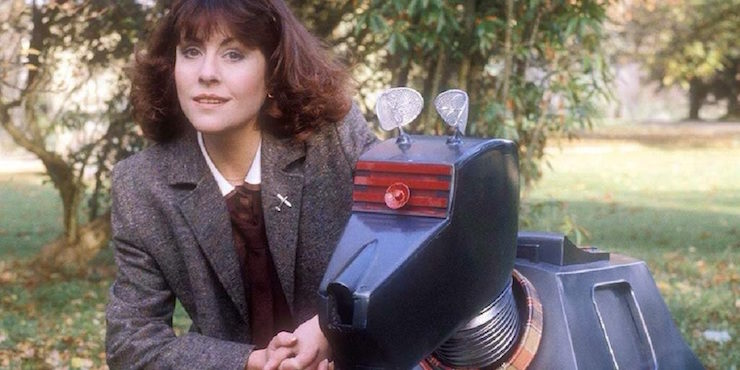“I have learned that life on Earth can be an adventure, too. You never know what you might find!”
Sarah Jane Smith was one of the most influential figures on me growing up, as a media representation of a professional working woman, as well as the “girl reporter” archetype.
In 1970s Doctor Who, the role of the female co-star evolved to someone who was a proper partner to the Doctor, if not entirely his equal. These included “Actually I have a doctorate too” Liz Shaw, “I got better marks at school than the Doctor” Romana, “I can rescue myself with skeleton keys” Jo Grant, and “I will stab you in your sleep” Leela.
But Sarah Jane Smith was the first Doctor Who companion who balanced an outside job with her TARDIS adventures. When we met her in “The Time Warrior,” she was investigating the same missing scientists plot as the Doctor and UNIT—indeed, for a good part of the story, she considers the Doctor a suspect.
She was also a vocal feminist in an era when that was a new concept. Sure, her feminism often comes off as awkward and unsubtle, bearing all the hallmarks of “man writes feminist,” but it’s still there and it’s important. Lines like “You’re still living in the middle ages” said to a genuine medieval woman, and Sarah Jane’s awkward faux pas when she assumed that the boss of Think Tank was a man, meant we weren’t always sure if her feminism was there to be mocked or appreciated… but with the extremely paternalistic, patronizing Third Doctor, it still felt like a breath of fresh air.
Her independence from the Doctor and his life, in those early stories, went hand in hand with her expectation of being treated as a person rather than a “girl.” In “Planet of the Spiders” and “Robot,” Sarah Jane again found her way to the main story without the Doctor serving as catalyst, because of her own fascination with odd science-based stories. It was so nice to see a companion with agency, instead of one trailing along in the Doctor’s wake, and some of those story beats can be seen in New Who companions.
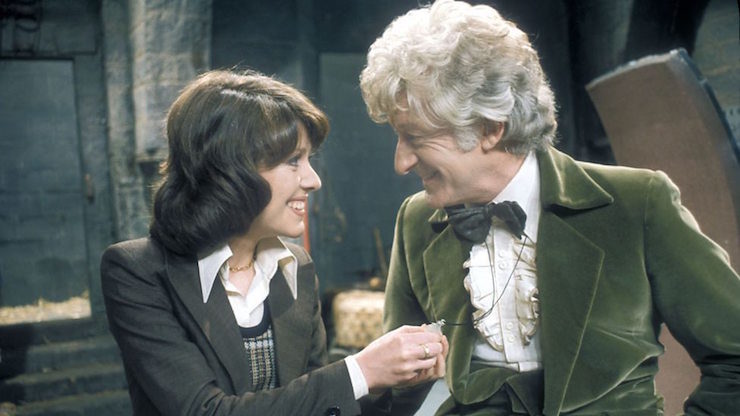
Sarah Jane’s journalism became less and less relevant to her adventures as the Fourth Doctor whisked her away in time and space on a more full time basis, but she continued to be bold, independent, and stand up for herself whenever she could escape the limitations of the scripts—which often reduced to a generic role of “screams, runs away, is hypnotised.”
All female co-stars of this generation had similar issues, often having to fight for scripts to be tailored to their specific character instead of that generic Doctor Who Girl archetype which kept creeping in thanks to writers who, like the producers and directors, were more interested in what was happening with the lead role and the male guest stars. Elisabeth Sladen herself talks about this issue in her posthumously published autobiography, and many of the other actresses from the ‘70s and ‘80s era of the show have discussed it at length. Louise Jameson and Sophie Aldred in particular had to remove screams from their scripts as a matter of course.
Ironically, in her final scene of “The Hand of Fear,” Sarah Jane blew up at the Doctor for exactly this issue: her moment of fury came out of frustration at the ridiculous number of things that made her feel unsafe while travelling with him. She declared her independence and packed her “goodies” to go home as an elaborate bluff—which, sadly, the Doctor called her on, sending her home because he had been summoned to Gallifrey and wasn’t willing to take a plus one.
This feels like a shockingly cruel decision on his part, until you remember that last time his companions were brought near Time Lords, they had their memories of him wiped. Good call, Doctor.
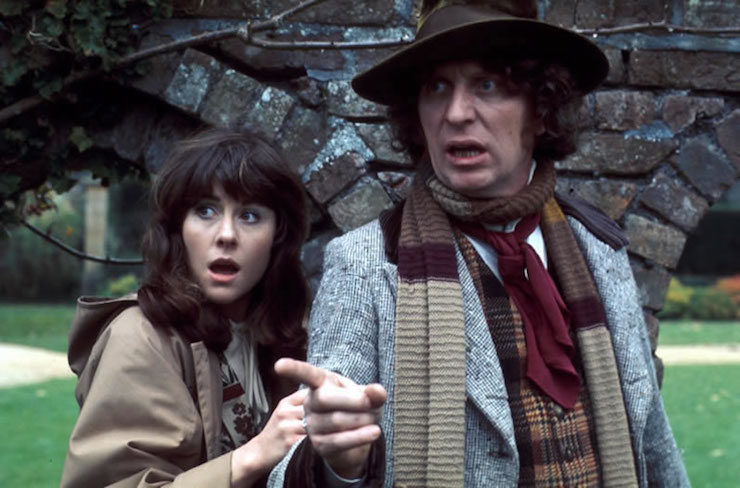
It’s a shame, though. “The Deadly Assassin,” a much-beloved-by-fandom 1976 classic which features no female characters whatsoever, would have been greatly improved by a suspicious Sarah falling in with the Gallifrey Free Press to cover the Presidential elections from her alien perspective.
Sarah’s active life and career made her a solid contender for a spin off series after her time in the TARDIS, with her journalistic exploits serving to lead her into the path of further danger, alien excitement and shenanigans, much as it had in her early Doctor Who stories.
K9 and Company (1980) never got beyond a pilot episode, and failed to live up to its jaunty Murder She Wrote opening credit sequence. But the key elements of Sarah’s future life were laid out here: she solves mysteries in a small town with the help of an enthusiastic young male relative and her robot dog. She’s now planning to write a book, we are told—what kind of book? A tell-all memoir about her UNIT years? A novel about space travel? A history of medieval feminism?
Sarah’s career and personality carried her through multiple spin offs including books and audios, far more than any other Doctor Who companion. The unique and authentic voice of Sarah Jane Smith as played by Elisabeth Sladen made her an ideal protagonist—she was never afraid to bulldoze in and start asking the difficult questions, despite it landing her in hot water.
Then Doctor Who returned in 2005, and Sarah Jane Smith—still a beloved favourite of many—was the classic companion chosen to make a return appearance.
“School Reunion” (2006) gave us a Third Doctor style adventure with our intrepid reporter investigating an alien mystery concurrently with the Doctor and his new companions, Rose and Mickey. The episode made a few unfortunate choices, such as retconning Sarah’s love for the Doctor as romantic (ugh) and implying her lack of husband or children was because of her pining away for him to return instead of her SUCCESSFUL CAREER. (Seriously, I can’t rewatch that episode without mentally editing out several lines of dialogue.)
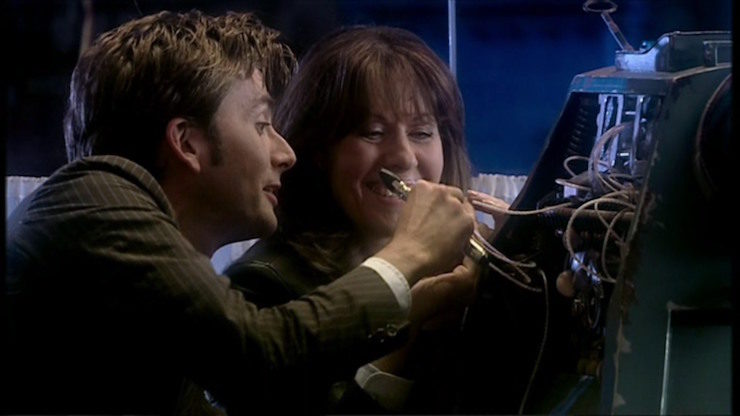
But this was still our Sarah Jane, with her nose for a story, using her experience with aliens and dodgy secret military organisations to find the juicy stuff.
Which raises the question: how and where exactly is she selling these stories?
The Sarah Jane Adventures (2007-2011) finally gave Sarah the spinoff success she deserved, as well as becoming a brilliant children’s TV series independent of its Doctor Who connections.
In her own TV show at last, Sarah Jane Smith (aged 59 when the show began) was a wonderful role model as a dynamic, older female action hero with brains. The show was diverse, fun, and progressive, with stories tackling such themes as adoption, amicable divorce, the perception of women as they age, homeless youth, etc. Plus aliens and time travel.
Sarah’s relationship with adopted son Luke was joyous and poignant, as the two of them struggled with the sheer awkwardness of becoming each other’s family. We learned more about Sarah herself—orphaned as a baby, raised by her busy career woman aunt. No wonder she never fell into a traditional relationship/family unit herself.
But what did the show have to say about journalism? This Sarah Jane regularly held up her career as a badge of honour, but we mostly saw her using her professional credentials to access areas for her hobby: tidying up the mess and baggage of aliens passing through London.
While Torchwood cleaned up the streets of alien detritus and stray invaders with high tech weaponry, sass and a seemingly endless budget for gratuitous vehicles, Sarah Jane did it as a form of emotional labour, providing support and care for aliens as often as she thwarted deadly invasions. She was far more likely to ask “How can I help?” as “What the hell are you doing here?” and there was a great deal of nuance in the alien situations she managed, unpaid, on behalf of humanity.
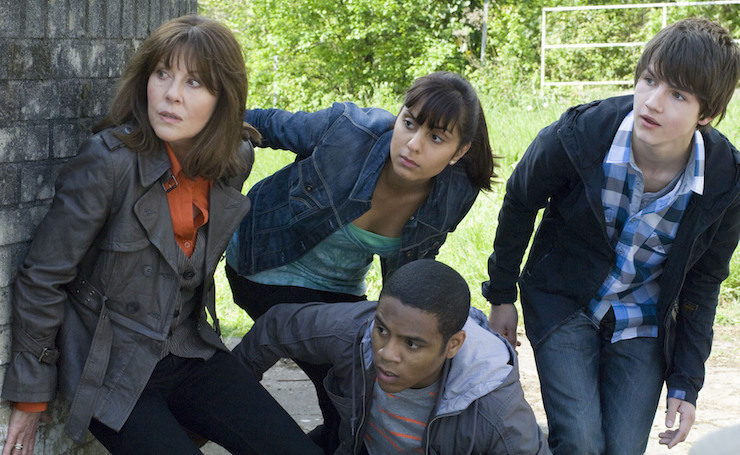
The Doctor, of course, also strides through the universe fixing problems without drawing a salary, but we rarely see him stopping to check on the social balance and personal wellbeing of the societies he topples and the overlords he conquers; though sometimes the companions he brings with him address those issues or at least ask the questions that he mostly ignores. Sarah Jane Smith, in her own show, spent a lot more time dealing with the aftermath and consequences of interactions between aliens and humanity. Unable to flit away in a TARDIS whenever things got sticky, she had to constantly monitor the awareness and experience of her neighbours, so as not to be outed as a saver of the world.
The introduction of Rani Chandra as a series regular, an ambitious “schoolgirl reporter,” helped to swing the focus back on to Sarah Jane’s original purpose, of digging out mysteries in the name of journalism. And yet, we still saw Sarah Jane and the kids shaping fake news and cover stories to hide alien truths far more often than we saw legitimate articles being filed with editors.
It was only in SJA’s fragmented unfinished final season (which was cut short due to the tragic and unexpected death of its star, Elisabeth Sladen) that the writers pulled back to restore Sarah Jane’s journalistic credentials and remind us that cleaning up alien messes was her vocation, not her profession.
In “The Man Who Never Was,” which ended up being her final story, Sarah Jane identified herself as one of Britain’s top journalists (you go girl!) and proved it with a high end invitation to an exclusive tech conference. The kids were genuinely startled by this revelation, and she replied by pointing out her affluent lifestyle, her nice car and house and clothes: she worked for this money and success and yes, she’s at the top of her field.
Sarah Jane Smith started out as sassy girl reporter with a very basic understanding of feminism, and ended up with an epic journalistic career and peer recognition of her work, as well as access to alien secrets no one else ever heard about; in her later years she did this while balancing the needs of her growing adoptive family as well as those of her community as a whole.
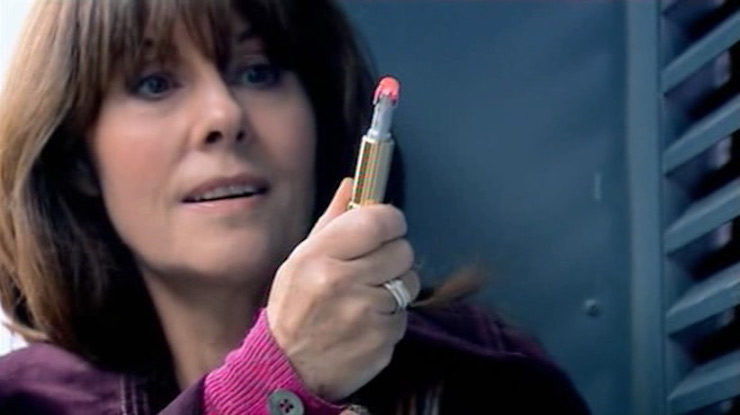
New Who, especially the Moffat era, has a tendency to write women whose life begins and ends with their time travelling in the TARDIS with the Doctor; they rail against leaving, knowing that this is the best time in their lives and nothing else can ever compare.
But despite what was implied in “School Reunion,” the best things in Sarah Jane’s life—her career success, friends, family and world-saving opportunities—all started after the Doctor abandoned her in a random suburban street in Aberdeen.
She had a robot dog, a super cute car, a sassy super computer in her attic, a fabulous career and people who loved her. Sure, she spent a lot of her time and resources crafting false media narratives to hide aliens from the Earth instead of telling the truth to her public, but she’s still a hell of a role model for young people everywhere.
Always be yourself, unless you can be Sarah Jane Smith. Then always be Sarah Jane Smith.
“There’s nothing only about being a girl, your Majesty.” —Sarah Jane Smith in conversation with Queen Thalira, “The Monster of Peladon” (1974)
 Tansy Rayner Roberts is an SFF writer and co-host of the Verity! Podcast: six smart women talking about Doctor Who. Her new novella about female journalists and superheroes, Girl Reporter, will be released on December 19. You can find Tansy on Twitter at @tansyrr.
Tansy Rayner Roberts is an SFF writer and co-host of the Verity! Podcast: six smart women talking about Doctor Who. Her new novella about female journalists and superheroes, Girl Reporter, will be released on December 19. You can find Tansy on Twitter at @tansyrr.










